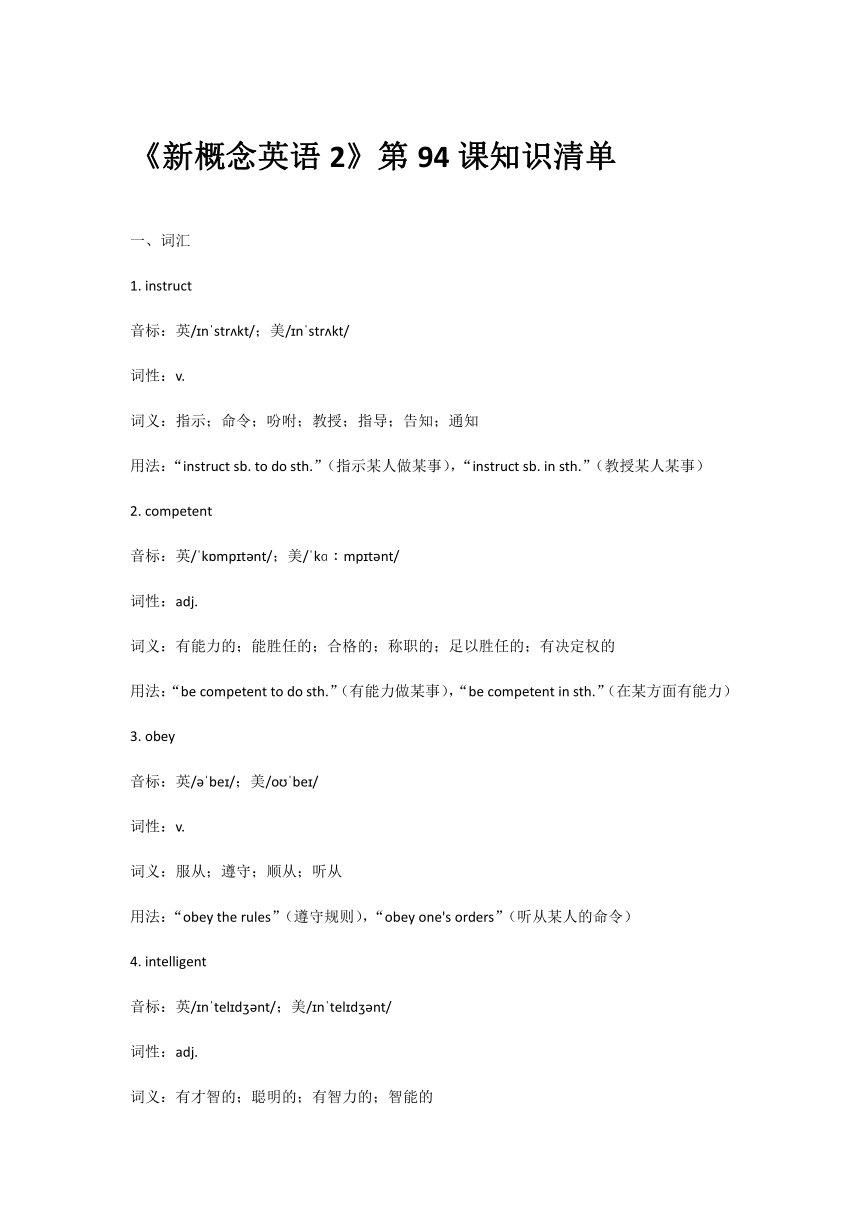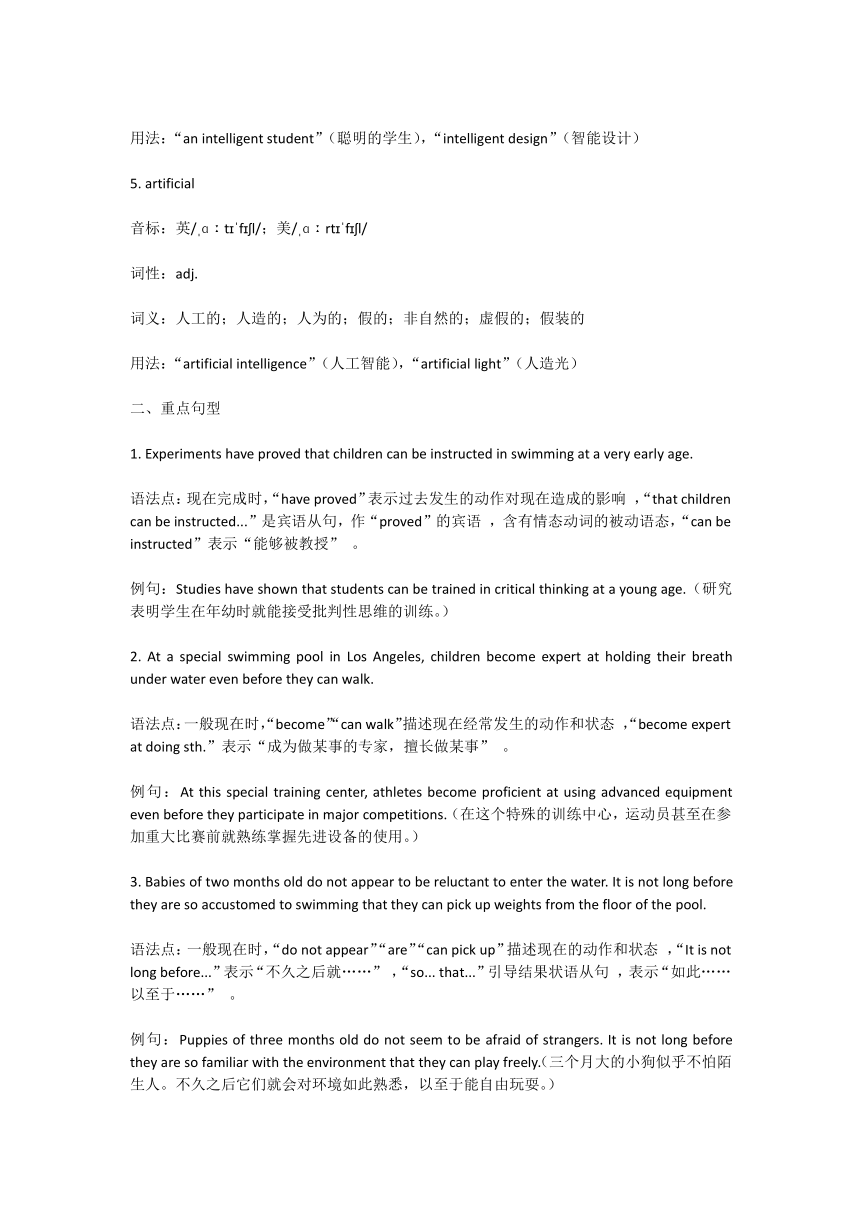新概念英语第二册Lesson 94 Future champions知识点
文档属性
| 名称 | 新概念英语第二册Lesson 94 Future champions知识点 |  | |
| 格式 | docx | ||
| 文件大小 | 20.8KB | ||
| 资源类型 | 教案 | ||
| 版本资源 | 新概念英语 | ||
| 科目 | 英语 | ||
| 更新时间 | 2025-03-05 13:34:13 | ||
图片预览


文档简介
《新概念英语2》第94课知识清单
一、词汇
1. instruct
音标:英/ n str kt/;美/ n str kt/
词性:v.
词义:指示;命令;吩咐;教授;指导;告知;通知
用法:“instruct sb. to do sth.”(指示某人做某事),“instruct sb. in sth.”(教授某人某事)
2. competent
音标:英/ k mp t nt/;美/ kɑ mp t nt/
词性:adj.
词义:有能力的;能胜任的;合格的;称职的;足以胜任的;有决定权的
用法:“be competent to do sth.”(有能力做某事),“be competent in sth.”(在某方面有能力)
3. obey
音标:英/ be /;美/o be /
词性:v.
词义:服从;遵守;顺从;听从
用法:“obey the rules”(遵守规则),“obey one's orders”(听从某人的命令)
4. intelligent
音标:英/ n tel d nt/;美/ n tel d nt/
词性:adj.
词义:有才智的;聪明的;有智力的;智能的
用法:“an intelligent student”(聪明的学生),“intelligent design”(智能设计)
5. artificial
音标:英/ ɑ t f l/;美/ ɑ rt f l/
词性:adj.
词义:人工的;人造的;人为的;假的;非自然的;虚假的;假装的
用法:“artificial intelligence”(人工智能),“artificial light”(人造光)
二、重点句型
1. Experiments have proved that children can be instructed in swimming at a very early age.
语法点:现在完成时,“have proved”表示过去发生的动作对现在造成的影响 ,“that children can be instructed...”是宾语从句,作“proved”的宾语 ,含有情态动词的被动语态,“can be instructed”表示“能够被教授” 。
例句:Studies have shown that students can be trained in critical thinking at a young age.(研究表明学生在年幼时就能接受批判性思维的训练。)
2. At a special swimming pool in Los Angeles, children become expert at holding their breath under water even before they can walk.
语法点:一般现在时,“become”“can walk”描述现在经常发生的动作和状态 ,“become expert at doing sth.”表示“成为做某事的专家,擅长做某事” 。
例句:At this special training center, athletes become proficient at using advanced equipment even before they participate in major competitions.(在这个特殊的训练中心,运动员甚至在参加重大比赛前就熟练掌握先进设备的使用。)
3. Babies of two months old do not appear to be reluctant to enter the water. It is not long before they are so accustomed to swimming that they can pick up weights from the floor of the pool.
语法点:一般现在时,“do not appear”“are”“can pick up”描述现在的动作和状态 ,“It is not long before...”表示“不久之后就……” ,“so... that...”引导结果状语从句 ,表示“如此……以至于……” 。
例句:Puppies of three months old do not seem to be afraid of strangers. It is not long before they are so familiar with the environment that they can play freely.(三个月大的小狗似乎不怕陌生人。不久之后它们就会对环境如此熟悉,以至于能自由玩耍。)
三、语法聚焦
1. 现在完成时
构成:主语+have/has+过去分词 。当主语是第三人称单数时用has,其他人称用have 。
用法:表示过去发生的动作对现在造成的影响或结果 ,常与already、yet、just等副词连用 ;表示从过去开始一直持续到现在的动作或状态 ,常与“for + 时间段”“since + 时间点”等连用 。如“I have already finished my homework.”(我已经完成作业了) ;He has lived here for five years.(他在这里住了五年了) 。
2. 宾语从句
构成:主句+引导词+从句 。引导词有:
that:在从句中无实际意义,只起连接作用,常可省略 ,当从句是陈述句时用that引导 。
if/whether:表示“是否” ,在从句中不充当成分 ,当从句是一般疑问句时用if或whether引导 。
连接代词:who(谁,主格)、whom(谁,宾格)、whose(谁的,所有格)、which(哪一个)、what(什么) ,在从句中充当主语、宾语、定语等成分 ,当从句是特殊疑问句且疑问词在从句中作主语、宾语、定语等成分时用连接代词引导 。
连接副词:when(何时)、where(何地)、why(为什么)、how(如何) ,在从句中充当状语 ,当从句是特殊疑问句且疑问词在从句中作状语时用连接副词引导 。
用法:在句子中作宾语 ,放在及物动词、介词或某些形容词之后 。如“I think (that) he is right.”(我认为他是对的) ;“I don't know if/whether he will come.”(我不知道他是否会来) 。
3. 含有情态动词的被动语态
构成:主语+情态动词+be + 过去分词 。
用法:表示主语是动作的承受者,且有情态动词的意义 。如“The work can be finished tomorrow.”(这项工作明天可以完成) 。
4. 一般现在时
构成:
肯定句:主语+动词原形(主语是第三人称单数时,动词加 -s或 -es )。如“I work”,“He works” 。
否定句:主语+don't/doesn't + 动词原形 。如“I don't work”,“He doesn't work” 。
一般疑问句:Do/Does + 主语 + 动词原形+其他?肯定回答:Yes, 主语 + do/does. 否定回答:No, 主语 + don't/doesn't. 如“Do you work ”“Does he work ”
用法:表示经常性、习惯性的动作或存在的状态 ;表示客观事实、普遍真理 ;在时间、条件状语从句中,用一般现在时表将来 。如“He often gets up at 6:30.”(他经常六点半起床) ;“The earth moves around the sun.”(地球围绕太阳转) 。
5. It is not long before... 句型
用法:表示“不久之后就……” ,“before”引导时间状语从句 ,从句常用一般现在时或一般将来时 。如“It was not long before he came back.”(不久之后他就回来了 ,过去时) ;“It is not long before they will start the project.”(不久之后他们就会开始这个项目 ,将来时) 。
6. so... that... 引导的结果状语从句
用法:“so + 形容词/副词 + that...” ,“so + 形容词 + a/an + 可数名词单数 + that...” ,“so + many/few + 可数名词复数 + that...” ,“so + much/little + 不可数名词 + that...” ,表示“如此……以至于……” ,强调结果 。如“She is so beautiful that everyone likes her.”(她如此美丽,以至于每个人都喜欢她) ;“There are so many people that we can't move.”(人太多了,我们都动不了) 。
四、文化拓展
1. 早期教育理念与实践
对儿童进行早期游泳教育 ,体现现代早期教育理念 ,重视儿童体能和技能发展 。不同文化对早期教育侧重点不同 ,但都关注儿童成长 ,通过各种方式挖掘儿童潜力 ,为未来发展奠定基础 。
2. 儿童体育教育与健康成长
儿童游泳训练有助于身体健康和心理素质培养 ,增强体质、锻炼意志 。在许多国家 ,体育教育是儿童教育重要组成部分 ,通过游泳等运动促进儿童全面发展 ,培养团队合作精神和竞争意识 。
一、词汇
1. instruct
音标:英/ n str kt/;美/ n str kt/
词性:v.
词义:指示;命令;吩咐;教授;指导;告知;通知
用法:“instruct sb. to do sth.”(指示某人做某事),“instruct sb. in sth.”(教授某人某事)
2. competent
音标:英/ k mp t nt/;美/ kɑ mp t nt/
词性:adj.
词义:有能力的;能胜任的;合格的;称职的;足以胜任的;有决定权的
用法:“be competent to do sth.”(有能力做某事),“be competent in sth.”(在某方面有能力)
3. obey
音标:英/ be /;美/o be /
词性:v.
词义:服从;遵守;顺从;听从
用法:“obey the rules”(遵守规则),“obey one's orders”(听从某人的命令)
4. intelligent
音标:英/ n tel d nt/;美/ n tel d nt/
词性:adj.
词义:有才智的;聪明的;有智力的;智能的
用法:“an intelligent student”(聪明的学生),“intelligent design”(智能设计)
5. artificial
音标:英/ ɑ t f l/;美/ ɑ rt f l/
词性:adj.
词义:人工的;人造的;人为的;假的;非自然的;虚假的;假装的
用法:“artificial intelligence”(人工智能),“artificial light”(人造光)
二、重点句型
1. Experiments have proved that children can be instructed in swimming at a very early age.
语法点:现在完成时,“have proved”表示过去发生的动作对现在造成的影响 ,“that children can be instructed...”是宾语从句,作“proved”的宾语 ,含有情态动词的被动语态,“can be instructed”表示“能够被教授” 。
例句:Studies have shown that students can be trained in critical thinking at a young age.(研究表明学生在年幼时就能接受批判性思维的训练。)
2. At a special swimming pool in Los Angeles, children become expert at holding their breath under water even before they can walk.
语法点:一般现在时,“become”“can walk”描述现在经常发生的动作和状态 ,“become expert at doing sth.”表示“成为做某事的专家,擅长做某事” 。
例句:At this special training center, athletes become proficient at using advanced equipment even before they participate in major competitions.(在这个特殊的训练中心,运动员甚至在参加重大比赛前就熟练掌握先进设备的使用。)
3. Babies of two months old do not appear to be reluctant to enter the water. It is not long before they are so accustomed to swimming that they can pick up weights from the floor of the pool.
语法点:一般现在时,“do not appear”“are”“can pick up”描述现在的动作和状态 ,“It is not long before...”表示“不久之后就……” ,“so... that...”引导结果状语从句 ,表示“如此……以至于……” 。
例句:Puppies of three months old do not seem to be afraid of strangers. It is not long before they are so familiar with the environment that they can play freely.(三个月大的小狗似乎不怕陌生人。不久之后它们就会对环境如此熟悉,以至于能自由玩耍。)
三、语法聚焦
1. 现在完成时
构成:主语+have/has+过去分词 。当主语是第三人称单数时用has,其他人称用have 。
用法:表示过去发生的动作对现在造成的影响或结果 ,常与already、yet、just等副词连用 ;表示从过去开始一直持续到现在的动作或状态 ,常与“for + 时间段”“since + 时间点”等连用 。如“I have already finished my homework.”(我已经完成作业了) ;He has lived here for five years.(他在这里住了五年了) 。
2. 宾语从句
构成:主句+引导词+从句 。引导词有:
that:在从句中无实际意义,只起连接作用,常可省略 ,当从句是陈述句时用that引导 。
if/whether:表示“是否” ,在从句中不充当成分 ,当从句是一般疑问句时用if或whether引导 。
连接代词:who(谁,主格)、whom(谁,宾格)、whose(谁的,所有格)、which(哪一个)、what(什么) ,在从句中充当主语、宾语、定语等成分 ,当从句是特殊疑问句且疑问词在从句中作主语、宾语、定语等成分时用连接代词引导 。
连接副词:when(何时)、where(何地)、why(为什么)、how(如何) ,在从句中充当状语 ,当从句是特殊疑问句且疑问词在从句中作状语时用连接副词引导 。
用法:在句子中作宾语 ,放在及物动词、介词或某些形容词之后 。如“I think (that) he is right.”(我认为他是对的) ;“I don't know if/whether he will come.”(我不知道他是否会来) 。
3. 含有情态动词的被动语态
构成:主语+情态动词+be + 过去分词 。
用法:表示主语是动作的承受者,且有情态动词的意义 。如“The work can be finished tomorrow.”(这项工作明天可以完成) 。
4. 一般现在时
构成:
肯定句:主语+动词原形(主语是第三人称单数时,动词加 -s或 -es )。如“I work”,“He works” 。
否定句:主语+don't/doesn't + 动词原形 。如“I don't work”,“He doesn't work” 。
一般疑问句:Do/Does + 主语 + 动词原形+其他?肯定回答:Yes, 主语 + do/does. 否定回答:No, 主语 + don't/doesn't. 如“Do you work ”“Does he work ”
用法:表示经常性、习惯性的动作或存在的状态 ;表示客观事实、普遍真理 ;在时间、条件状语从句中,用一般现在时表将来 。如“He often gets up at 6:30.”(他经常六点半起床) ;“The earth moves around the sun.”(地球围绕太阳转) 。
5. It is not long before... 句型
用法:表示“不久之后就……” ,“before”引导时间状语从句 ,从句常用一般现在时或一般将来时 。如“It was not long before he came back.”(不久之后他就回来了 ,过去时) ;“It is not long before they will start the project.”(不久之后他们就会开始这个项目 ,将来时) 。
6. so... that... 引导的结果状语从句
用法:“so + 形容词/副词 + that...” ,“so + 形容词 + a/an + 可数名词单数 + that...” ,“so + many/few + 可数名词复数 + that...” ,“so + much/little + 不可数名词 + that...” ,表示“如此……以至于……” ,强调结果 。如“She is so beautiful that everyone likes her.”(她如此美丽,以至于每个人都喜欢她) ;“There are so many people that we can't move.”(人太多了,我们都动不了) 。
四、文化拓展
1. 早期教育理念与实践
对儿童进行早期游泳教育 ,体现现代早期教育理念 ,重视儿童体能和技能发展 。不同文化对早期教育侧重点不同 ,但都关注儿童成长 ,通过各种方式挖掘儿童潜力 ,为未来发展奠定基础 。
2. 儿童体育教育与健康成长
儿童游泳训练有助于身体健康和心理素质培养 ,增强体质、锻炼意志 。在许多国家 ,体育教育是儿童教育重要组成部分 ,通过游泳等运动促进儿童全面发展 ,培养团队合作精神和竞争意识 。
同课章节目录
